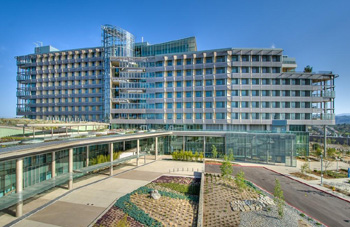Green Hospital Earns Recognition for Embracing Technology
 ESCONDIDO, Calif. — Since opening in August 2012, the $956 million Palomar Medical Center West in Escondido has earned several accolades for its commitment to sustainable building practices. Technology and patient-centric design were also key factors in its success.
ESCONDIDO, Calif. — Since opening in August 2012, the $956 million Palomar Medical Center West in Escondido has earned several accolades for its commitment to sustainable building practices. Technology and patient-centric design were also key factors in its success.
The 740,000-square-foot facility features 288 single-patient rooms, 50 emergency and trauma rooms, 12 operation rooms, six interventional radiology suites and three terraces, with full-size trees, flowers, shrubs and patio seating.
Los Angeles-based CO Architects served as the design architect on the project and incorporated several green elements into the design, including a 1.5-acre green roof, garden areas on every level of the 11-story nursing tower and daylighting features that were transmitted using ground-to-ceiling panels of Solarban 70XL and Solarban 60 glasses.
The greenery and daylighting elements were a large part of the patient-focused design that uses nature to help with the healing process. Solarban 70XL and Solarban 60 glasses are transparent, solar controlled, low-emissivity glasses that allow high levels of daylight into a space while still blocking solar heat gain, which eliminates the need for artificial lighting and air conditioning — two notorious energy suckers.
“The design simultaneously embraces the natural world and the world of medical technology in a flexible, sustainable and evidence-based environment of care,” said CO Architects Principal and Project Director Tom Chessum, FAIA in a statement. “This visionary ‘hospital of the future’ was realized through an integrated form of project delivery involving building information modeling and advanced teaming practices.”
Along with green design elements, the hospital embraced some of the latest technologies, earning it the self-proclaimed “Hospital of the Future” title. First, they used an information technology system designed by Cisco to equip staff with phones that access the Internet, allowing them to receive real-time patient information and even calls from patient rooms. Patient calls are automatically sent to their nurse’s phone, and if the nurse is unavailable, it’s sent to a backup staff member.
This technology allowed for the hospital to do away with traditional nurse stations and use a fully distributed model so that nurses could walk the floor next to the patients. The nurse stations are located outside of the patient rooms, where they can do charting while still watching over the patients. The system also makes it so that there is no overhead intercom system that disrupts those in the facility.
The hospital also incorporated other innovative technologies based on patient care, including infrared technology that illuminates faucets when someone enters a patient room, reminding them to wash their hands. There are also robots developed by VGo that allow patients to telecommute with friends and family, even from the healing gardens.
Another key technology: a device that allows for remote monitoring of patient vital signs, created by Sotera Wireless. Patients can wear the monitor around their wrist, and it constantly feeds information back to the medical record, allowing patients to become mobile as early as possible.
The construction project was even innovative before construction by building a virtual hospital on Second Life. It was used as a way for the staff and community to comment on design features, and Palomar Medical Center plans on using the same virtual world in the future when it develops a new rehab hospital and long-term care facility.
The 288-bed medical center is now one of the largest buildings in the U.S. and was constructed using an integrated project delivery method. It was the largest project under construction in California when the team broke ground in 2007. Redwood City-based DPR Construction served as the construction manager beginning in 2008.
